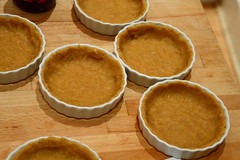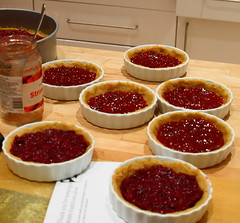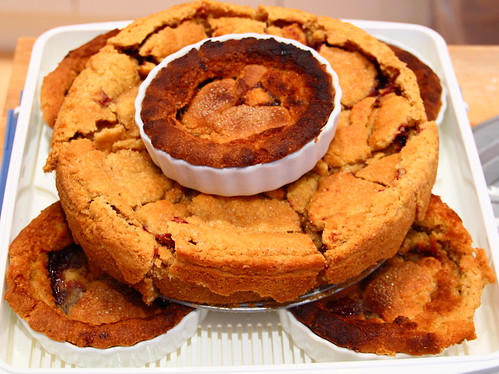T’s mother used to make greens every New Year’s day. Occasionally she even made black-eyed peas. These were the foods she’d eaten every New Year’s Day as a child, because her mother followed that strangest of Southern traditions, and made her children something called “hoppin’ john.” Southerners eat black-eyed peas on New Year’s Day to attract luck, and they eat greens, so that money will come in the New Year.
Obviously, this worked for T’s family. That — or continuing to go to work — ensured that they have never yet gone bankrupt and become destitute and homeless.
T., however, is not a huge proponent of the New Year’s Day scenario. First, she knows that D. really hates cooked veg, especially greens — and while she loves them, a.) most of them don’t love her, seeing as they’re high in oxalic acid, and b.) there’s not much point cooking anything for one person that the other won’t eat. Another reason for avoidance is, if T. stays up ’til midnight, her body figures it’s time to eat again — and she’s just not eating greens at midnight, no matter how tasty they might be. A New Year’s Day celebration meal that comes in the middle of the night calls for pancakes. Silver dollar pancakes, to be sure — for the money attractant aspect of things. And syrup — a lovely bitter orange syrup made of the leftover simple syrup from candying oranges — makes the perfect representative food of love.
So, we expect love and money in the New Year. And, you know, to still be trying to be healthy, since that’s obviously what the puddle of earnest and healthful margarine represents. (It’d be a whole ‘nother story if that were butter.)
But what, you ask, about the black-eyed peas?
Welllll, D. kind of hates those, too. Or, rather, he did. And actually, T. wasn’t so fond of the dried kind — until she remembered — or misremembered? — a dish of them she enjoyed in childhood, made by some Jamaican friends. T. did a little experimenting, and came up with a good first try at the dish, and we both actually enjoyed it — which is a good thing. Black-eyed peas are cheap (thus explaining the frugal Southerners serving them), and fiber-full, which is probably a good thing the usual meal of four calling birds, three French hens, two turtledoves and a neighborhood of gingerbread houses that most people eat for Christmas dinner, and continue to snack on throughout the week between the 25th and New Year’s Day. Not to mention the fudge…
This is a rough guess at what we did to make this dish — and keep in mind, it’s a work in progress!
Misremembered Peas & Rice
- 2 c. black-eyed peas – sorted and soaked
- About 8 C. water
- 2 cloves of garlic
- 2 spring onions, bruised and 2 Tbsp. onion powder
- 1 tsp. salt, and of freshly ground black pepper
- 2 fresh sprigs of thyme, bruised, or 2 tsp. dried
- 1/4 tsp. paprika, and ginger
- 1 C. rice
- 1 can coconut milk
- 1 whole hot pepper, like Scotch Bonnet or a Thai chile, optional
First, sort your beans — this is imperative. This time of year, the only black-eyed peas you’ll find are dried and harvested peas, and the harvesting process inevitably brings along little rocks. Measure out your two cups, pour them a bit at a time on a flat surface, and pick through them. It’s a chore myriad Southern children spent many an evening doing…
Soak your beans in water in a covered pot overnight. For some people, black-eyed peas cause more gastrointestinal distress than other beans, and soaking them overnight and tossing out the water helps with that. If you haven’t time for a whole overnight thing, pour your beans into boiling water, boil for two minutes, and then allow to sit for one hour. Discard the water, and Bob’s your uncle. And Bob might not have a gassy stomach, which would benefit your familial relationship greatly.Next, smash your garlic cloves with the flat of your knife, into a paste, and add to the 8 cups of boiling water. Add the drained beans and simmer for an hour to an hour and a half, depending on how old your beans were to begin with, and how high of an altitude you’re at — beans can be tricky, but most of them give up the ghost after an hour. Simply do a “squish test” against the lid of the pot. You want your black-eyed peas to have give, but not be completely mush, so do check on that simmer at the hour mark!
Then, add your coconut milk, rice, salt, black pepper, onion powder, paprika, ginger, and spring onions (or scallions) and thyme to the mix. Please note that the aromatics are beaten and bruised with the flat of your knife, not chopped, according to the visual of the finished dish that T. retains from when her friends made it. (Mind you, T. never lets anything like the way one is supposed to do things stop her, and she chopped a plain old onion into hers, but she practically made a paste of it, and sweated it before she added it to the beans, so it was invisible — but then, she has a THING about adding onions to savory foods. Ignore her. Carry on.) At this time, if you’d like your dish to be slightly spicy, toss in your whole hot pepper – don’t chop it! Simply boiling it in the coconut milk and the juices from the beans will impart a “glow” to the dish that non-pepper lovers will even enjoy.The rice should be cooked through in forty minutes — keep an eye on the dish at this stage, and don’t hesitate to add a teensy bit more water (no more than a quarter cup), if your bean juice is quite thick and you feel there’s not enough liquid to adequately cook the rice. Remove your bedraggled veg matter – pepper, thyme and onions — and serve with a dusting of thyme and pepper to taste.
The reason this is called Misremembered Peas & Rice — is because the dish actually calls for kidney beans! T. swears she had it with black-eyed peas, but she may have recalled one of her mother’s experiments and not Mrs. Shand’s dish. Either way – it’s a creamy, tasty, yummy dish, with just a hint of coconut scent, and a subtle fire — and a good way to get down those black-eyed peas, even if you’re not fond of them.
And why should you be trying so hard to eat them? Because 1 cup (172g) plain cooked black-eyed peas is only 199 calories, 35g of carbohydrate (11% of the American recommended daily allowance), 11g of fiber (44% RDA) and 13g of protein, which is rare in beans (And ½ cup of cooked black-eyed peas counts as 1 oz. of lean meat from the Meat, Poultry, Fish, Dry Beans, Eggs, And Nuts Group of the Food Guide Pyramid.). Plus, they’re pretty tasty. Even if they’re not the bean you were supposed to use.



















